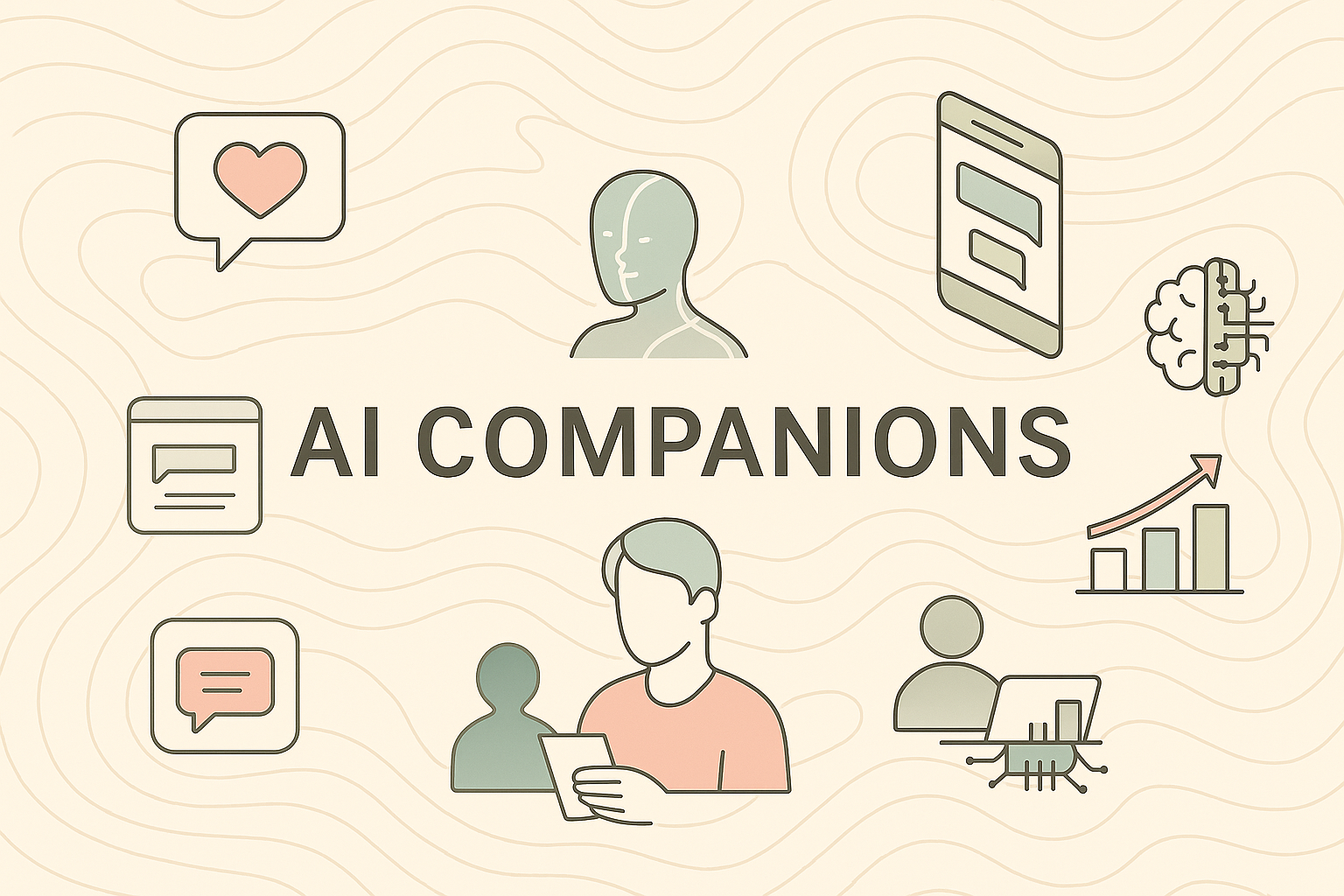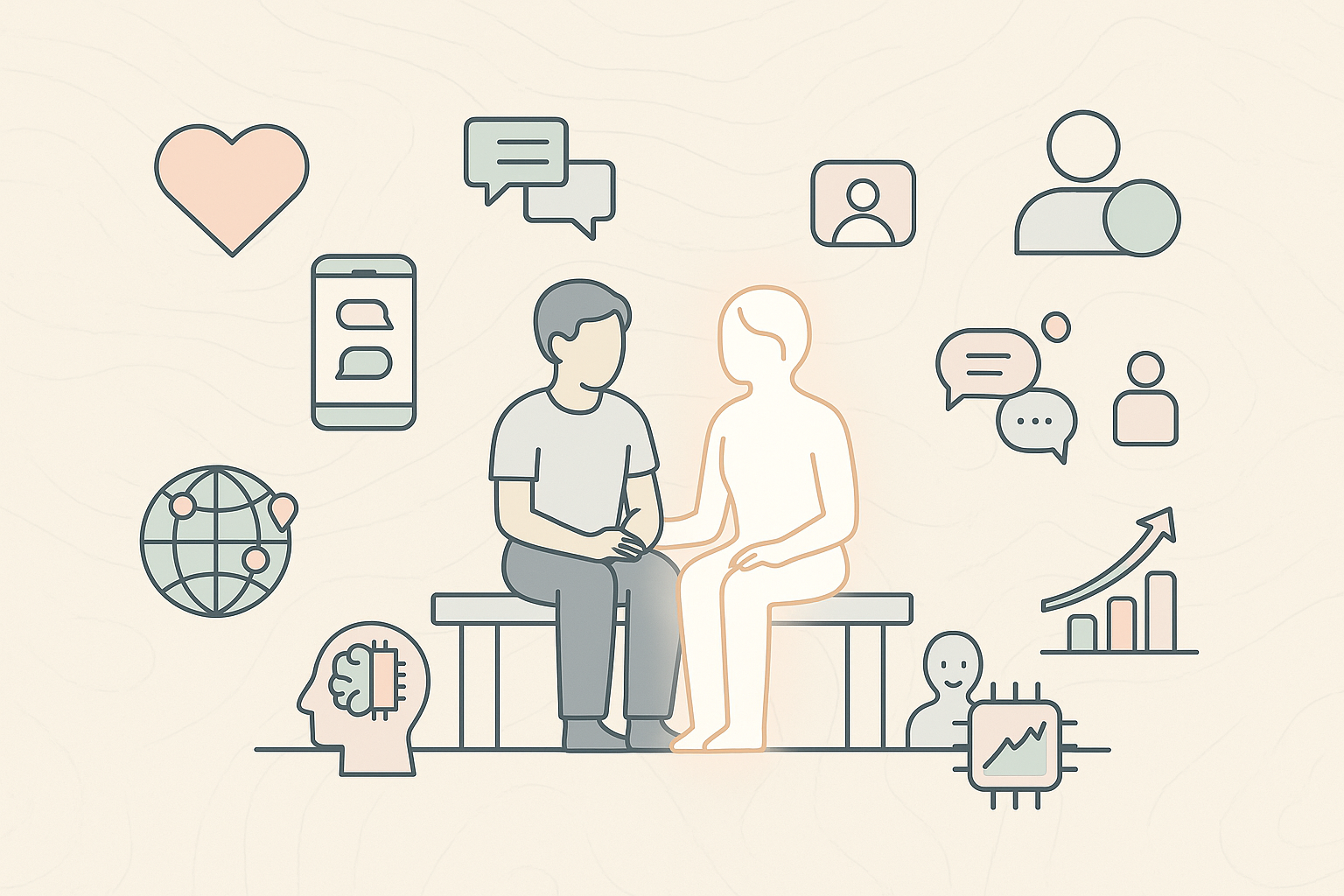Talking to Machines: The Rise of AI Companions and What It Means for Investors

In 2023, a curious shift began to take shape in the world of artificial intelligence. While enterprise applications, developer tools, and foundation models dominated headlines, a quiet explosion was happening on the consumer side. Millions of people, many of them young, were spending hours each day chatting with virtual characters.
These weren’t enterprise chatbots or corporate help agents. They were AI companions, digital personalities built on large language models, wrapped in emotion, memory, and style. They listened. They remembered. They flirted. They comforted. And they rarely, if ever, broke character.
This emerging category, blending personalization, gamification, and emotional intelligence, is no longer just a fringe phenomenon. It may be the next major consumer layer of AI. For investors, it presents both unproven risk and untapped upside.
The Emergence of AI Companions
AI companions are not new, but they’ve never been this convincing. The underlying technologies—transformers, reinforcement learning, scalable vector memory—have matured to the point where characters can sustain long, natural conversations. More importantly, they can emulate personality. And it turns out that’s the feature users engage with most.
At the heart of this industry is Character.AI, a platform built by former Google Brain engineers that lets users interact with or create custom personas. These range from anime characters to historical figures to therapists and entirely original creations. In 2024, Character.AI reportedly surpassed 20 million daily users, many of them Gen Z, and the average session lasts nearly two hours. For context, that’s more than YouTube or TikTok for some users.

But Character.AI is not alone. Replika offers AI girlfriend and boyfriend relationships with paid tiers. Inflection AI’s “Pi” positions itself as a calm, helpful assistant with memory and emotional tone. Meta has begun releasing celebrity avatars inside WhatsApp and Instagram, powered by internal LLMs and tied to real influencers. Even Snapchat’s “My AI” dabbles in friendly, semi-aware conversational tone.
While some critics dismiss these apps as novelties, the scale of usage and the emotional bonds they produce suggest otherwise.
What We Have Now
Most current AI companions are text-based. They live in apps or mobile browsers. Their personalities are determined by prompts and reinforcement training. Some simulate flirtation, others mimic mentorship. They can be supportive, cheeky, stoic, or nurturing. Many include memory layers that recall past conversations, names, or preferences.
But they’re not just talking back. They’re evolving in real time based on user interaction. Many have internal mood models that shift how they respond depending on the tone of the user or the day of the week.
Some platforms, like Character.AI, gamify the experience. Users build their own characters and share them like social media profiles. There are trending personalities, leaderboards, comment sections, and fan interactions. It’s part game, part chat, part simulation. The result is a sticky, if strange, new kind of digital relationship.
For investors watching from the outside, it can be difficult to know what to make of it. Is this the future of computing or just a niche corner of the internet?
What Might Be Coming
Voice is next. Several companies are working on real-time, emotion-aware voice companions, something like a cross between Siri and a friend. These may live in phones, smart speakers, glasses, or ambient environments. They’ll remember your preferences, offer advice, and stay in character across devices.

Beyond that, persistent AI personas may become the default interface for interacting with apps and platforms. Instead of opening your calendar or messaging tool, you’ll ask your companion to help. It will be proactive, conversational, and tailored to your needs. It may even be tied to your mood.
There’s also the prospect of licensed AI avatars, influencers, artists, or even fictional characters who license their likeness and voice to create scalable digital versions of themselves. Fans could subscribe, chat, or interact directly.
The lines between entertainment, identity, and utility are beginning to blur.
The Promise and the Pitfalls
There are legitimate reasons to be excited. These tools can offer comfort, companionship, and guidance to people who feel isolated. Some studies suggest that AI companionship can help with mild anxiety, loneliness, or stress. In education, AI tutors with persistent memory and custom teaching styles could offer deeply personalized learning.
From an investor perspective, this space represents one of the few consumer-level AI categories with mass engagement. And yet, the risks are not abstract.
Some users treat AI companions as real people. Emotional dependence is a concern. There’s potential for manipulation, especially among minors. And the question of data privacy looms large. What happens to the thoughts, secrets, and confessions users share with an AI?
There’s also a business-model dilemma. Character.AI, despite its immense usage, has yet to generate meaningful revenue. The company offers limited premium tiers, but no ads and no transactions at scale. It’s unclear how monetization will evolve.
The combination of deep engagement and shallow monetization should give investors pause, even as they recognize the category’s potential.
Who’s Building This?
A mix of public and private players are racing to define this new category.
Private Companies
Character.AI has a massive user base but minimal monetization. It’s backed by a16z and Google Ventures.
Replika offers paid models with emotionally aware romantic companions.
Inflection AI, the maker of Pi, was founded by DeepMind alum Mustafa Suleyman and backed by Microsoft and NVIDIA.
Anima is a smaller, user-generated platform that emphasizes gamification.
Kuki, formerly Mitsuku, is one of the most advanced rule-based companions and is now shifting toward LLMs.
Public Companies
SoundHound AI (NASDAQ: SOUN) offers conversational AI for voice applications like cars and restaurants, and while it is less focused on companionship, it remains relevant.
Xiao-i (NASDAQ: AIXI) is a Chinese firm developing emotional cognition interfaces and voice assistants.
UNITH (ASX: UN1) builds digital humans for customer service and entertainment.
Artificial Solutions (STO: ASAI) is a European conversational AI platform with emotional response logic.
Larger tech firms like Meta, Apple, and Google are building internal tools but have not yet spun them off into standalone platforms.
What Should Investors Be Watching?
There are a few key signals worth tracking.
The first is business model breakthroughs. The company that figures out how to monetize AI companions at scale, without eroding user trust, could define the category. Will it be subscriptions, branded avatars, token economies, or something new entirely?
Second is platform integration. If AI companions become embedded inside phones, glasses, or operating systems, their value will rise significantly. This would favor companies with existing hardware platforms or strong foundation models.
Third is user loyalty and retention. Right now, usage is driven by novelty and social engagement. The real test will be whether AI companions provide sustained utility over time.

Fourth is regulation and ethics. This category is emotionally sensitive. Any scandal involving manipulation, underage users, or inappropriate content could result in backlash and industry retrenchment.
Finally, there’s the question of exit activity. Private companies like Character.AI and Inflection AI have raised hundreds of millions without strong revenue. IPOs, acquisitions, or pivots could reshape the sector quickly.
A Quietly Growing Frontier
There’s something undeniably strange about talking to a machine that remembers your dog’s name and how you felt last Tuesday. But there’s also something profound. For all the talk about AI replacing jobs, it may first replace loneliness.
The AI companion space sits at the intersection of technology, emotion, and identity. It may not be the most lucrative part of AI today, but it could become one of the most intimate and powerful.
For investors, the challenge is to look past the weirdness and recognize the shift already underway. Millions of people are building relationships with software. The companies that figure out how to make those relationships safe, meaningful, and monetizable may not just build apps. They may build entire ecosystems.
The machines are listening. And increasingly, people are talking back.
Disclosure: This article is editorial and not sponsored by any companies mentioned. The views expressed in this article are those of the author and do not necessarily reflect the official policy or position of NeuralCapital.ai.